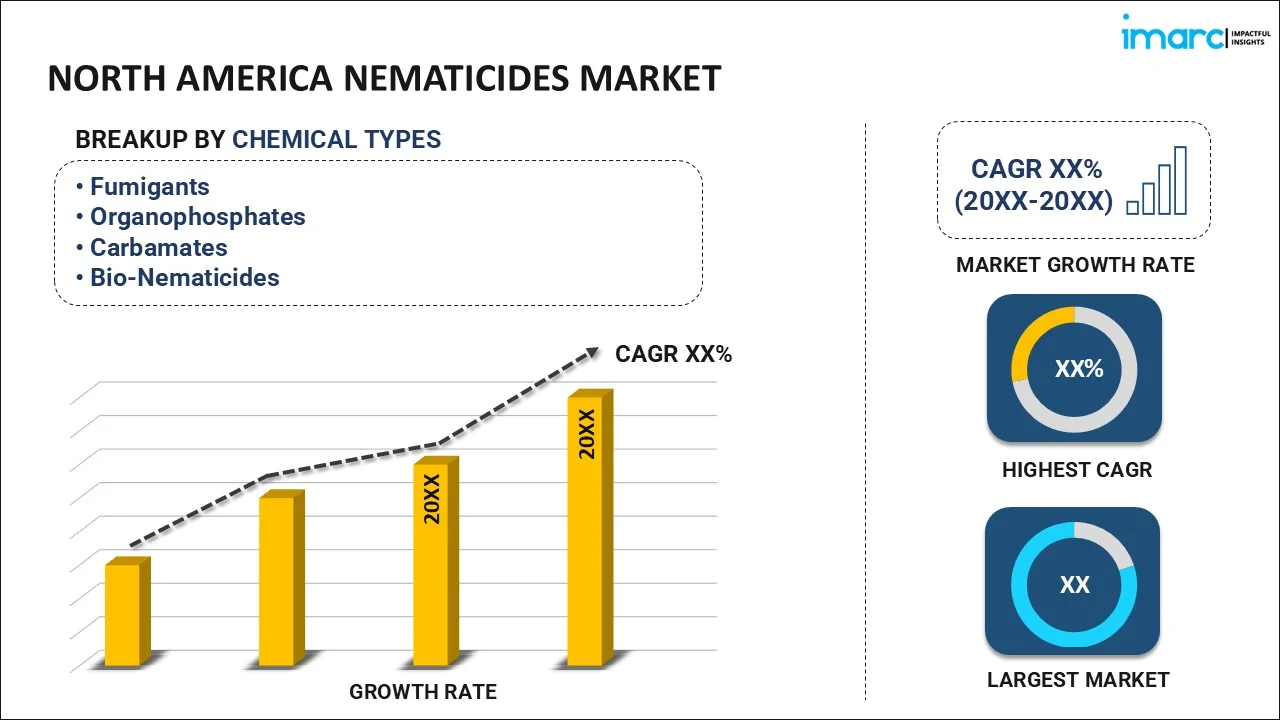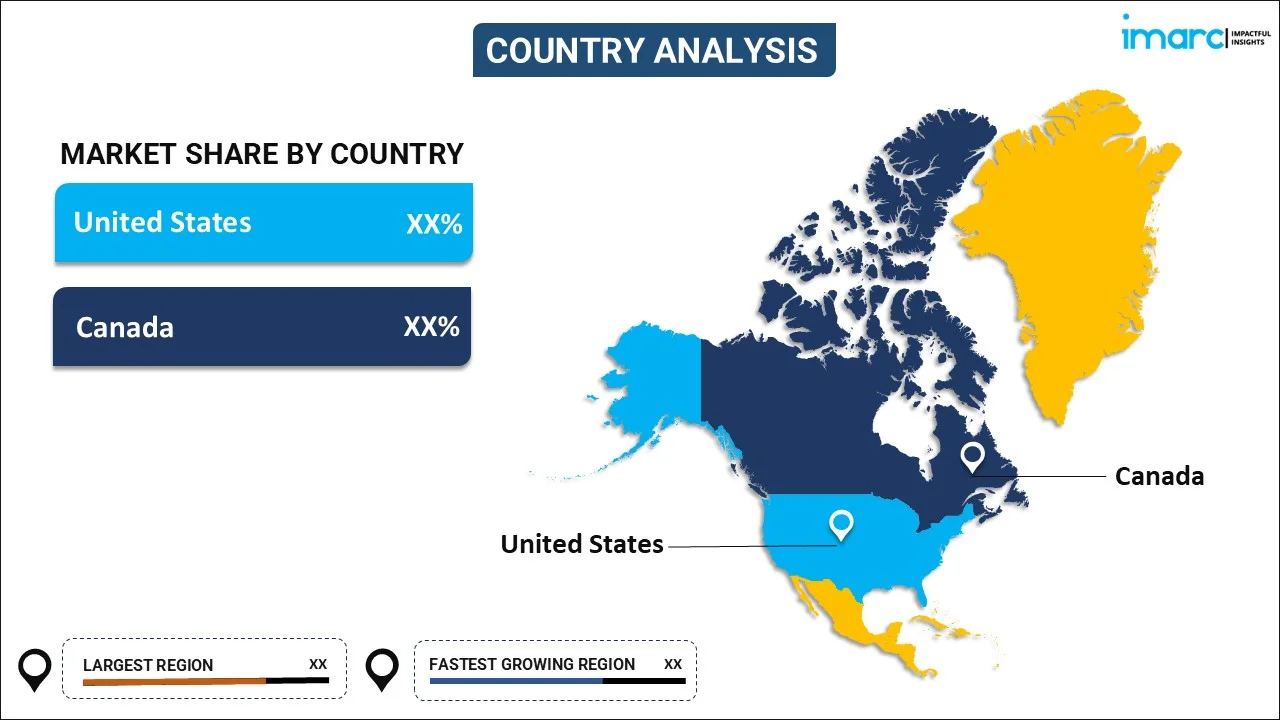
North America Nematicides Market Size, Share, Trends and Forecast by Chemical Type, Nematode Type, Formulation, Application, and Country, 2025-2033
North America Nematicides Market Overview:
The North America nematicides market size reached USD 427.07 Million in 2024. Looking forward, IMARC Group expects the market to reach USD 602.62 Million by 2033, exhibiting a growth rate (CAGR) of 3.90% during 2025-2033. The North America nematicides market is fueled by the growing demand for high crop yields, necessity to manage nematode infestations, increased awareness about soil health, use of sustainable agriculture practices, government regulations relating to the use of pesticides, and innovation in nematicide formulations for efficient pest management.
|
Report Attribute
|
Key Statistics
|
|---|---|
|
Base Year
|
2024 |
|
Forecast Years
|
2025-2033
|
|
Historical Years
|
2019-2024
|
| Market Size in 2024 | USD 427.07 Million |
| Market Forecast in 2033 | USD 602.62 Million |
| Market Growth Rate (2025-2033) | 3.90% |
North America Nematicides Market Trends:
Increasing Demand for Biological and Eco-friendly Nematicides
One of the most prominent trends fueling the North American nematicides market is the increasing demand for biological and organic nematicides. With consumers becoming increasingly green-conscious and governments implementing more stringent regulations on the application of chemical pesticides, farmers are looking for alternative means of managing nematode populations. Moreover, in recent times 22 European Union member states; Switzerland; and US states of New Jersey, Maine, and Nevada have imposed strict restrictive bans on a number of neonicotinoid pesticide types. Biological nematicides, which are sourced from nature such as bacteria, fungi, and plant extracts, provide a more environmentally friendly and sustainable means of controlling nematode infestations. Chemical nematicides have been the preferred method of controlling nematodes for a long time, but their negative effects on the environment, such as soil erosion, water pollution, and damage to beneficial insects, have led farmers to turn to biological methods. Biological nematicides, e.g., those derived from Bacillus species, Paecilomyces lilacinus, and Neem, act to interfere with the reproduction of nematodes, prevent their development, or create an unfavorable habitat for them. These products would be more specific, targeting the pests only without harming the favorable microorganisms of the soil. Therefore, governments worldwide have been making efforts toward easing research and development operations for environment-friendly nematicides. Recently, the European Patent Office has awarded Futureco Bioscience, a Spanish biotech firm specializing in the research, development, and production of biological products, a new patent for a new microbial bionematicide technology.
Rising Adoption of Integrated Pest Management (IPM) Strategies
Another prominent trend in the North American nematicides market is the increasing adoption of Integrated Pest Management (IPM) strategies. IPM is a holistic approach that combines various pest control methods to manage pest populations in a sustainable and environmentally responsible manner. This approach focuses on prevention, monitoring, and the use of multiple control techniques, including biological, chemical, cultural, and mechanical practices, to minimize the use of chemical nematicides. The rise of IPM is a direct response to the growing concerns over the over-reliance on chemical pesticides and nematicides. Farmers are increasingly looking for ways to manage nematode populations while minimizing the environmental impact of synthetic chemicals. IPM promotes the use of nematicides as a last resort, encouraging farmers to explore alternative control methods, such as crop rotation, resistant plant varieties, and soil health management. There have been some government initiatives in this regard towards school IPM programs so that kids would not unnecessarily come in contact with toxic pesticides. Based on statistics, more than 53 million children and 6 million adults in America spend a significant portion of their days at more than 120,000 public and private schools. IPM offers a chance to build a healthier learning environment—keeping children away from pesticides while also removing pests. One of the key components of IPM is the use of biological control agents, which align with the trend of adopting eco-friendly nematicides. These biological agents, including nematode predators, parasitic fungi, and nematicidal bacteria, are incorporated into IPM strategies to control nematode populations naturally. By reducing the reliance on chemical nematicides, IPM helps to preserve soil health, protect beneficial organisms, and reduce the risk of pest resistance.
North America Nematicides Market Segmentation:
IMARC Group provides an analysis of the key trends in each segment of the market, along with forecasts at the country level for 2025-2033. Our report has categorized the market based on chemical type, nematode type, formulation, application and country.
Chemical Type Insights:

- Fumigants
- Organophosphates
- Carbamates
- Bio-Nematicides
The report has provided a detailed breakup and analysis of the market based on the chemical type. This includes fumigants, organophosphates, carbamates and bio-nematicides.
Nematode Type Insights:
- Root-knot Nematode
- Cyst Nematode
- Others
A detailed breakup and analysis of the market based on the nematode type have also been provided in the report. This includes root-knot nematode, cyst nematode and others.
Formulation Insights:
- Liquid
- Granular
- Emulsifiable Concentrates
- Others
The report has provided a detailed breakup and analysis of the market based on the formulation. This includes liquid, granular, emulsifiable concentrates and others.
Application Insights:
- Grains and Cereals
- Pulses and Oilseeds
- Commercial Crops
- Fruits and Vegetables
- Others
A detailed breakup and analysis of the market based on the application have also been provided in the report. This includes grains and cereals, pulses and oilseeds, commercial crops, fruits and vegetables, and others.
Country Insights:

- United States
- Canada
The report has also provided a comprehensive analysis of all the major regional markets, which include Unites States and Canada.
Competitive Landscape:
The market research report has also provided a comprehensive analysis of the competitive landscape. Competitive analysis such as market structure, key player positioning, top winning strategies, competitive dashboard, and company evaluation quadrant has been covered in the report. Also, detailed profiles of all major companies have been provided.
North America Nematicides Market News:
- In June 2024, BASF Agricultural Solutions introduced its new Nemasphere™ which is a nematode resistance trait. It is one of the groundbreaking innovations in soybean cyst nematode (SCN) management in the span of 60 years.
- Corteva has introduced Reklemel active, a new nematicide that is designed to safeguard a broad spectrum of food and row crops from plant-parasitic nematode injury while preserving the healthy equilibrium of beneficial soil biota. Reklemel active was invented and created by Corteva and represents the culmination of over a decade of research and investment.
- UPL Corp ("UPL"), the provider of integrated and sustainable agriculture solutions, announced that NIMAXXA™ bionematicide, the novel triple-strain bionematicide seed treatment with season-long nematode protection for soybeans and corn, has been registered by the U.S. Environmental Protection Agency. It is effective against the most damaging nematodes, including soybean cyst nematode (SCN), root knot nematode (RKN), and reniform nematode.
North America Nematicides Market Report Coverage:
| Report Features | Details |
|---|---|
| Base Year of the Analysis | 2024 |
| Historical Period | 2019-2024 |
| Forecast Period | 2025-2033 |
| Units | Million USD |
| Scope of the Report |
Exploration of Historical Trends and Market Outlook, Industry Catalysts and Challenges, Segment-Wise Historical and Future Market Assessment:
|
| Chemical Types Covered | Fumigants, Organophosphates, Carbamates and Bio-nematicides |
| Nematode Types Covered | Root-knot Nematode, Cyst Nematode and Others |
| Formulations Covered | Liquid, Granular, Emulsifiable Concentrates and Others |
| Applications Covered | Grains and Cereals, Pulses and Oilseeds, Commercial Crops, Fruits and Vegetables, and Others |
| Countries Covered | United States, Canada |
| Customization Scope | 10% Free Customization |
| Post-Sale Analyst Support | 10-12 Weeks |
| Delivery Format | PDF and Excel through Email (We can also provide the editable version of the report in PPT/Word format on special request) |
Key Questions Answered in This Report:
- How has the North America nematicides market performed so far and how will it perform in the coming years?
- What is the breakup of the North America nematicides market on the basis of Chemical Type?
- What is the breakup of the North America nematicides market on the basis of Nematode Type?
- What are the various stages in the value chain of the North America nematicides market?
- What are the key driving factors and challenges in the North America nematicides market?
- What is the structure of the North America nematicides market and who are the key players?
- What is the degree of competition in the North America nematicides market?
Key Benefits for Stakeholders:
- IMARC’s industry report offers a comprehensive quantitative analysis of various market segments, historical and current market trends, market forecasts, and dynamics of the North America nematicides market from 2019-2033.
- The research report provides the latest information on the market drivers, challenges, and opportunities in the North America nematicides market.
- Porter's five forces analysis assist stakeholders in assessing the impact of new entrants, competitive rivalry, supplier power, buyer power, and the threat of substitution. It helps stakeholders to analyze the level of competition within the North America nematicides industry and its attractiveness.
- Competitive landscape allows stakeholders to understand their competitive environment and provides an insight into the current positions of key players in the market.
Need more help?
- Speak to our experienced analysts for insights on the current market scenarios.
- Include additional segments and countries to customize the report as per your requirement.
- Gain an unparalleled competitive advantage in your domain by understanding how to utilize the report and positively impacting your operations and revenue.
- For further assistance, please connect with our analysts.
 Inquire Before Buying
Inquire Before Buying
 Speak to an Analyst
Speak to an Analyst
 Request Brochure
Request Brochure
 Request Customization
Request Customization




.webp)




.webp)












